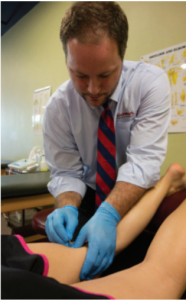Dry Needling and How Can It Help Pain

 Do you ever wish you could push the “reset” button on your aching muscles?
Do you ever wish you could push the “reset” button on your aching muscles?
A technique being utilized by BenchMark Physical Therapy and specially trained therapists across the nation is doing just that, moving the needle on pain.
Dry needling, a new physical therapy treatment, may be the best choice for your injuries, aches, and pains. This method has gained a popular reputation as an effective treatment for pain relief, stiffness, and improving range of motion and flexibility. It is often used to treat sports and orthopedic injuries, but can also be successful for treating chronic pain and fibromyalgia. For years, dry needling was performed in Europe before becoming mainstream in the United States.
Dry needling, often called “trigger point dry needling” or “intramuscular stimulation,” involves inserting a very thin filament needle into a “trigger point” or muscle spasm that sends pain to a specific area of the body. A trained therapist penetrates the ultrafine needle through all layers of the skin to reach the muscle, striking a “trigger point.” A trigger point is a taut band in the muscle that is often painful and can restrict range of motion and adequate blood flow to the area. The needle helps the therapist target tissues that cannot be reached with just the hands alone. The needle is “dry” because nothing is being injected, as in a flu vaccine needle or cortisone injection. With dry needling, the sterile needle is very thin and solid.
The goals of the treatment are to promote healing and improve blood flow. Benefits also include increased muscle flexibility, decreased muscle tension, and the deactivating of painful trigger points. Dry needling can also improve the brain’s ability to activate muscles, inhibit pain and improve function, often providing immediate and significant relief of symptoms.
To perform dry needling, a physical therapist must be certified, and have at least a year of experience. Typically, dry needling is conservative to start with to see how the patient responds. Over time, the technique can become increasingly aggressive. Making sure patients know what to expect from dry needling prior to their first treatment and making them feel comfortable is important. The procedure is rarely used in isolation. It is frequently used in conjunction with manual therapy, exercise, stretching, and an alternating regimen of heat and ice.
If you would like to try dry needling, talk to your physician or physical therapist, and see if the procedure can be part of an overall treatment plan that can get you back to feeling better, with the stroke of a needle.
Dry Needling Commonly Treated Conditions:
• Tendonitis and muscle strain
• Low back pain & sciatica
• Carpal tunnel syndrome
• Tennis elbow
• Neck pain & tension headache
• Piriformis syndrome
• Plantar fasciitis
• Fibromyalgia
• Rotator cuff injuries
• Athletic and sports-related injuries
BenchMark Rehab Partners is a family of physical therapists, occupational therapists, and hand therapists committed to inspiring and empowering people to reach their full potential. Its providers know that connecting with patients on a personal level helps to build trust. This trust is crucial in allowing patients and therapists to work together to make the best use of advanced certifications and refined techniques. A focus on proven methods and a hands-on approach help the BenchMark team achieve the goals of the patient in a safe and effective manner.
BenchMark Rehab Partners • bmrp.com• 1-866-577-7342



